Working Capital
Working capital is a financial metric used to measure a company’s operational liquidity, efficiency, and short-term financial health. It is calculated as the difference between a company’s current assets and current liabilities. In other words, working capital assesses what a company has left over in short-term assets after paying off its short-term liabilities.
Formula:
Working Capital = Current Assets − Current Liabilities
Components:
- Current Assets: These are assets that are expected to be converted into cash, sold, or consumed within a year or within the operating cycle of the business, whichever is longer. This usually includes cash, accounts receivable, inventory, and other short-term assets.
- Current Liabilities: These are obligations that the company needs to settle within a year or within its operating cycle, whichever is longer. This generally includes accounts payable, short-term loans, and other short-term debts.
Importance of Working Capital:
- Liquidity: Adequate working capital ensures that a company has enough cash or liquid assets to meet its short-term obligations, such as paying suppliers or employees.
- Solvency: Low working capital could indicate a risk of insolvency, where the company is unable to meet its short-term debts, potentially leading to financial distress or bankruptcy.
- Operations: Sufficient working capital is needed for a company to maintain its day-to-day operations, such as buying inventory, paying utilities, and covering other operational expenses.
- Growth: Excess working capital can be invested in expanding business operations, such as increasing inventory or hiring more staff, which could lead to increased revenues.
- Creditworthiness: A healthy working capital position can make it easier for a company to obtain financing from lenders or investors because it indicates good financial health and operational efficiency.
Types of Working Capital:
- Positive Working Capital: Indicates that a company has more current assets than current liabilities. It is generally a sign of financial health, but excessively high working capital might indicate inefficiency in using resources.
- Negative Working Capital: Suggests that a company has more current liabilities than current assets. While this might indicate a risk, some businesses operate effectively with negative working capital if they can turn over inventory quickly or have strong revenue growth prospects.
- Net Working Capital: Another term for working capital, often used to emphasize that it is a net amount, representing the balance between current assets and current liabilities.
Working capital is a vital metric for investors, creditors, and financial analysts, as it gives a quick snapshot of a company’s short-term financial condition and operational efficiency.
Example of Working Capital
Let’s consider a fictional company called “FreshBread Bakery” to illustrate the concept of working capital.
FreshBread Bakery’s Financials:
Current Assets:
- Cash: $20,000
- Accounts Receivable: $8,000
- Inventory: $12,000
Current Liabilities:
- Accounts Payable: $10,000
- Short-term Loans: $5,000
Calculation of Working Capital:
Working Capital = Current Assets − Current Liabilities
Working Capital = ($20,000 + $8,000 + $12,000) – ($10,000 + $5,000)
Working Capital = $40,000 – $15,000
Working Capital = $25,000
Analysis:
- Liquidity: FreshBread Bakery has a working capital of $25,000, indicating that it has enough liquidity to pay off its short-term obligations ($15,000) and still have a cushion left.
- Solvency: The positive working capital suggests that the company is not at immediate risk of insolvency.
- Operations: With $25,000 in working capital, FreshBread Bakery can comfortably manage its day-to-day operations, such as purchasing more flour and yeast for bread production or covering utility costs.
- Growth Potential: The company has excess working capital, part of which can be invested in growth initiatives like marketing, hiring additional staff, or expanding the product line.
- Creditworthiness: A healthy working capital position may make it easier for FreshBread Bakery to obtain additional financing or negotiate better terms with suppliers.
- Efficiency: While a high working capital is generally positive, it would be prudent for FreshBread Bakery to assess whether this capital is being used efficiently. Holding onto too much inventory or having a large amount of unpaid accounts receivable could tie up funds that could be used more productively.
In summary, the working capital of $25,000 gives FreshBread Bakery the financial stability to maintain, and potentially grow, its operations. However, the company should continually monitor this metric and make adjustments as necessary to ensure optimal financial health and operational efficiency.













